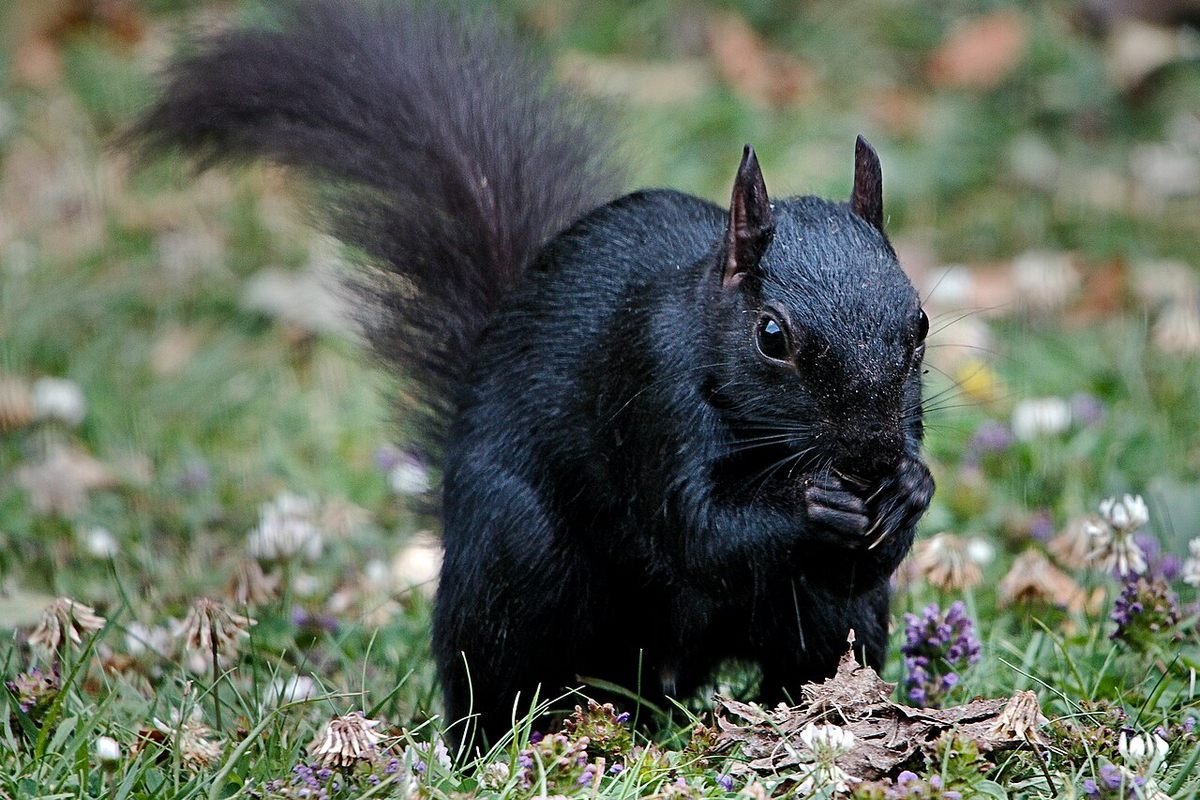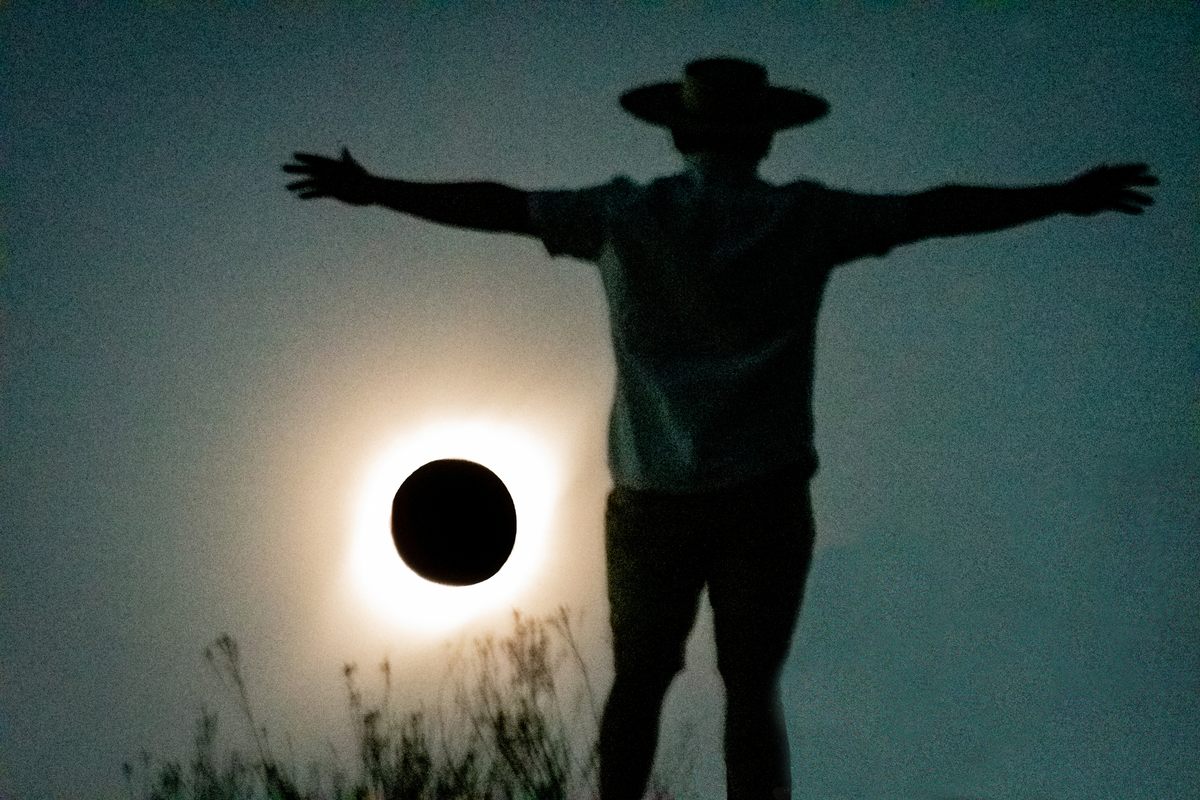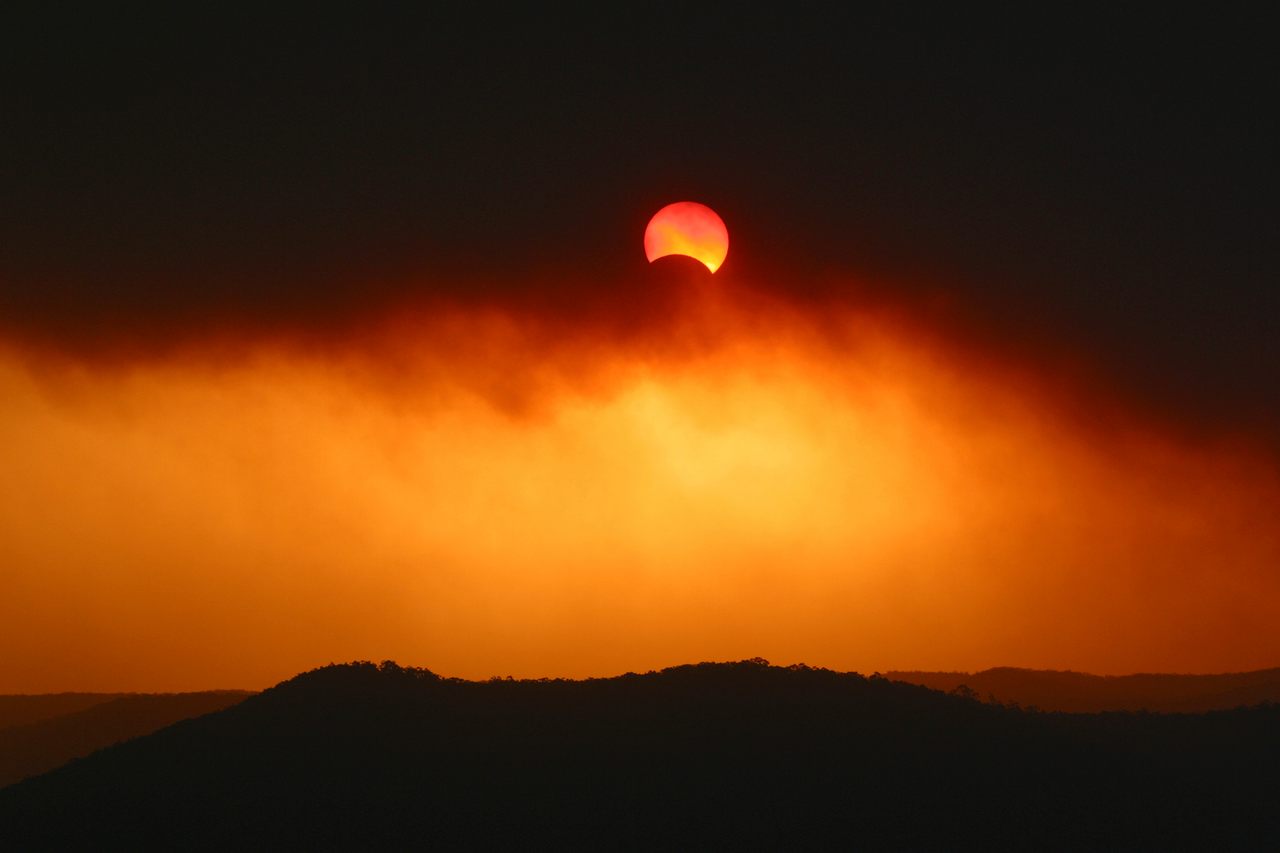Indigenous Solar Eclipse Stories From Across Turtle Island
From rodents of unusual size to flaming arrows, communities across North America share solar eclipse traditions.
On a clear, sunny day in the southeastern United States—long before the U.S. itself existed—members of the Choctaw Nation took notice of the Sun slowly disappearing, as if it was being eaten away. Despite it being midday, the crowd was now standing in an eerie darkness, submerged in the shadow of a solar eclipse, or hvshi kania, “the sun goes away.”
People began to run outside, banging pots and shouting at the sky. They yelled upwards not to show anger with the Sun—which they revered as God’s eye—but in its defense. One traditional Choctaw story blames the temporary disappearance of the sun on one or more hungry black squirrels known as Fʋni Lusa.
“When the sun began to get less in his brightness, and grow dark and obscure, they believed that some ethereal black squirrels of large size, driven by hunger, had commenced eating him and were going to devour him,” Israel Folsom, a Choctaw minister and Trail of Tears survivor, once said, according to the Choctaw Nation Historic Preservation Department. “With this belief, they thought it was their duty to make every exertion they could to save the great luminary of day from being consumed by them. Therefore, every person, men, women, and children, who could make a noise, were called upon to join in the effort to drive the squirrels away.”


People threw sticks and shot arrows at the sky while yelling for the squirrels to go. As the sun started to return, the noise turned into cheers. “People yell Funi-lusa-osh mahlatah! Meaning ‘the black squirrel is frightened,’” said Dawn Standridge, a cultural researcher for a Choctaw Nation nonprofit in Oklahoma, in a video about the eclipse tradition.
It’s more of a story to be shared than a modern day celebration, Standridge tells me over the phone. But Standridge and some other members of Choctaw communities in Oklahoma will be bringing the traditional story to life during the solar eclipse on April 8. Standridge is taking advantage of the path of totality passing over their land in Garvin, Oklahoma, to hold an eclipse event. They plan to tell the story of Fʋni Lusa and then mark the eclipse with plenty of noisemaking. Standridge hopes that telling the story of the solar eclipse will introduce people to other Choctaw stories and history.
As the April eclipse’s 115-mile-wide path of totality travels through Mexico, the U.S.—crossing from Texas to Maine—and Canada, Indigenous communities around North America will have the opportunity to recall their own unique traditions around the celestial event.
In the Cherokee Nation, just north of the path of totality for April’s event, eclipse traditions involve yelling at a giant frog in the sky. Robert Lewis, a Cherokee artist and cultural storyteller, remembers elder Sam Nofire teaching him the story of the frog. “A long time ago, all the animals would talk and tell us stories, telling us why things are the way they are,” says Lewis. The story says that the giant frog occasionally gets an appetite for the Sun.

When the Sun began to disappear, the Cherokee people would yell, bang pots, shake turtle shell rattles, and shoot guns—when they had them—at the frog. Today, the tradition is centered around storytelling, rather than actually making noise, says Lewis. “The last time I told this story I said ‘Alright, nobody pull out any guns or anything,’” he says with a laugh.
Instead of running toward the eclipse like the Cherokee, Navajo traditions say to do the opposite, says Lewis, who is also Apache and Navajo. “The Navajo, they don’t go out during eclipses,” he says. “They hide and they don’t go out and look at it at all.” The Navajo, or Diné, honor the eclipse as a sacred natural phenomenon explained as the death and rebirth of the sun (Jóhonaa’éí), according to a statement by the Institute for Diné Culture, Philosophy & Government. Death is a sacred event to Diné, demanding the utmost respect. “There is only one way to be reverent during an eclipse,” the statement reads. “No short cuts exist.” Throughout the day of the solar event, people are supposed to fast, stay indoors, remain calm, and avoid bathing and sex.
During the eclipse itself, people must look downward, like animals do. “As an example, sheep knew what to do already,” Carlos Begay, a Navajo culture and language teacher at Page High School in Arizona, told 12News. “They wouldn’t graze anymore, they would settle in, put their heads down, not even sleep, just huddle. So that tells you as a human being something is going on with nature. So animal behavior guides us.”
“During the eclipse, one must be in full prayer and reverence,” the statement continued. Sometimes these prayers are done in song. The death, birth, and renewal prayers will finish with the sun’s rebirth and the offering and consumption of corn pollen.
If you don’t follow the protocol, there can be repercussions, tradition says, including eye problems, sunburn, and digestive issues. Pregnant women are believed to be particularly at risk during an eclipse—a concern also found in Sonora, Mexico, where some expectant mothers will still take tradition-based precautions, such as wearing red shirts and ribbons or silver pins.
Many Diné people still honor their eclipse traditions, closing schools and workplaces to stay home. In October 2023, while tourists flocked to the Southwest for an annular eclipse—where the moon doesn’t completely obstruct the sun, leaving a visible “ring of fire”— the Navajo Nation closed Monument Valley Navajo Tribal Park to observe the tradition.
April’s eclipse path of totality won’t touch Navajo Nation, which will see a partial eclipse instead. Most Indigenous communities of the Great Lakes region will also see a partial eclipse. Among them, the Ojibwe and Cree peoples share a story of a boy named Tcikabis.

“In the old days, people were not the chiefs and did not hunt animals,” First Nations astronomer Laurie Rousseau-Nepton, from Quebec, Canada, said in a video. “Animals were the chiefs and hunted people. They killed everyone except for one girl and her little brother.” The boy learned to hunt with a bow and arrow, targeting birds and squirrels and eventually bigger prey. One day, he noticed he was being followed, as he felt a growing heat on the back of his neck. He followed the tracks of his stalker—the Sun—and set a snare. When the Sun rose in the morning it became caught in the boy’s trap. Many animals tried to come to Sun’s aid. Big moose and caribou went first, to no avail. When birds flew toward the sun their feathers caught fire. Then, a mouse as big as a mountain took a turn. The mouse chewed through the snare to set the sun free, but the sun’s heat shrank the mouse to the tiny size we know today.
In another Ojibwe story, the Sun was extinguished during an eclipse, so people shot flaming arrows into the sky until it was relit.
Whether shooting flaming arrows or yelling skyward, these stories may have evolved as a way to provide comfort, and a sense of agency, in a time of uncertainty. “When you know a story and its outcome, you can perhaps face phenomena that might be scary or feel unpredictable with a blueprint of how to understand it,” David O’Connor, the Wisconsin Department of Public Instruction’s American Indian studies consultant wrote in a statement on the department’s website.
Lewis hopes sharing traditional stories with native and non-native communities alike can remind people of how to be good to each other and the Earth. “Storytelling is part of our culture and a tool for learning,” says Lewis. “Our Native culture is about being respectful of everybody…and to the landscape itself.”


























Follow us on Twitter to get the latest on the world's hidden wonders.
Like us on Facebook to get the latest on the world's hidden wonders.
Follow us on Twitter Like us on Facebook